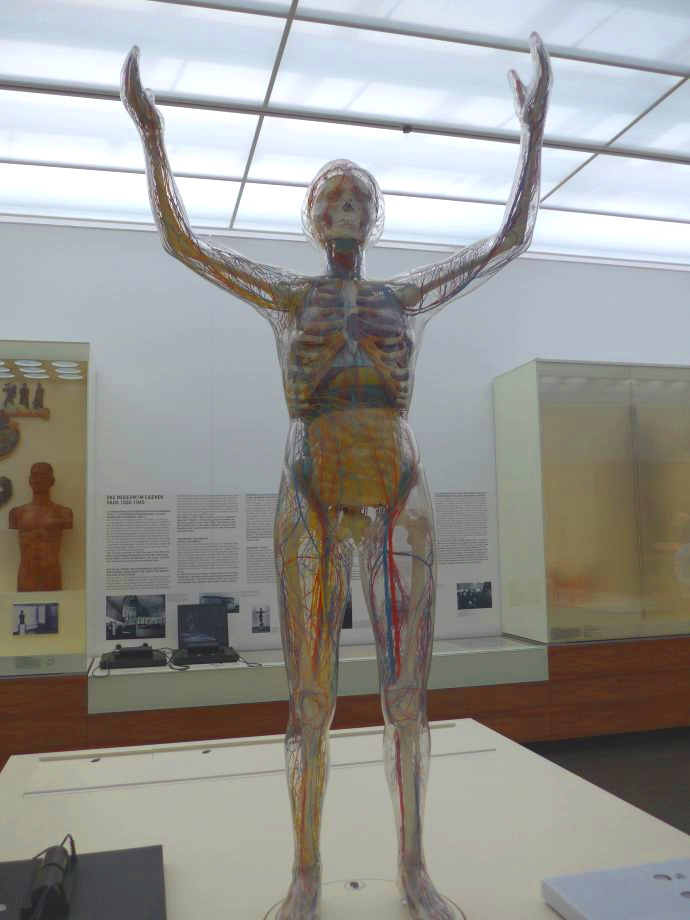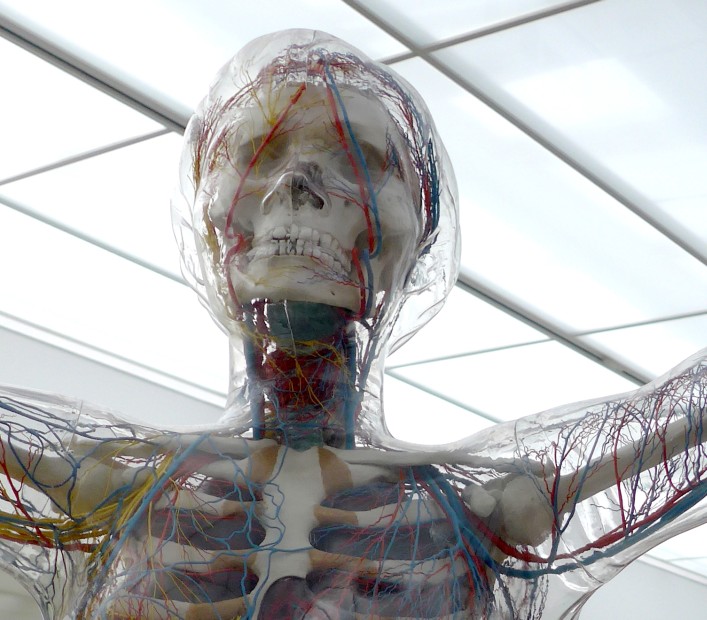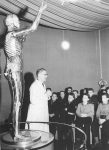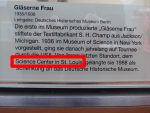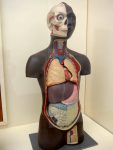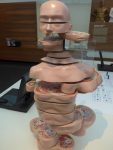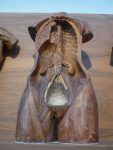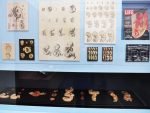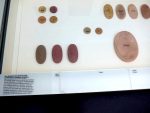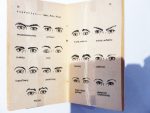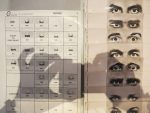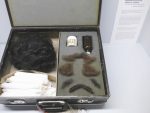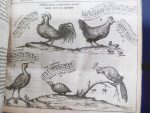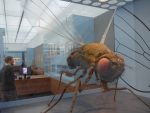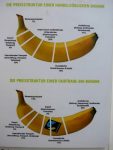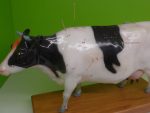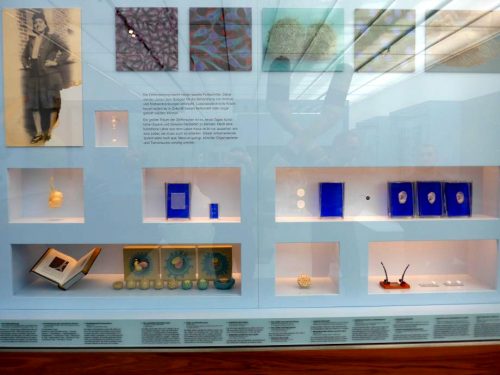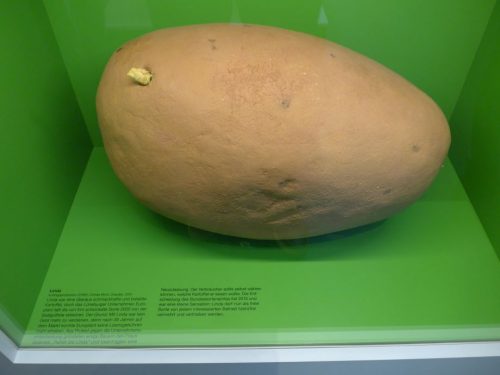I finally solved the thirty-year-running mystery of whatever happened to the life-size illuminated transparent woman model in the St. Louis Museum of Science and Natural History after it closed in 1988. When it reopened as a new hands-on discovery center a few years later – with the history, charm and occasional mystery sanitized away, as in most science museums since the 1980s – the Transparent Woman was gone.
St. Louis was far from the only city whose science museum had a transparent woman in the previous century. I always wondered if this one ended up in another museum or in a rich person’s house, or did they throw her away? It turns out she went back to her birthplace in, astonishingly, Dresden, Germany, specifically the German Hygiene Museum, where she is now on display. The museum workshop built her in 1935 as the first in what would eventually be a series of 70 transparent women, 56 men, eight cows, and five horses that were used in traveling exhibitions and sold to museums around the world. Dresden is in eastern Germany, which of course was the separate communist country of East Germany when the St. Louis museum obtained the model around the 1950s, and it was still East Germany when they donated it back in 1988. The museum stopped building them in 1990 when communism ended and Germany reunited.
The Hygiene Museum itself is fascinating and a must for anyone interested in the history of science or public hleath, as it still has some displays from the 1910s through 60s. The name dates back to its founding as the First International Hygiene Exposition by a mouthwash tycoon in 1912, with ‘hygiene’ referring to all aspects of physical and mental health. A blockbuster success, it soon branched out into traveling exhibits and the educational medical model business, selling the models around the world (see dirty diapers below).
Sadly, much of it has fallen victim to the same trends as science museums everywhere since the 80s or so, with dumbed-down gimmicks for short attention spans, and I don’t have photos of those parts. Most of what you see here is pre-1980s exhibits that have so far survived unscathed. Cross your fingers they’ll remain in place.
Left and center: c. 1930s to 1960s
Right: Clumsy attempt from 1992 to jump on some sort of pop-psychology bandwagon about how underwear hides yet exposes the human body. Reasonable idea but weak execution.
The only reason I took this photo is that it’s illegal to do so due to Germany’s law that says embryos are people and have a right to life (the sign said embryo, not fetus for some reason) and so you’d have to get permission from their guardian to take their picture – despite the fact that (A) abortion is completely allowed in Germany and (B) if you just took a photo in the museum where any living visitors were in the frame you wouldn’t need their permission – any more than you need permission from random strangers who show up in any photo you take outdoors in public (an established legal principle) – so why would you need permission for an unidentifiable blob? I other words the law protects the privacy of the fetuses, which can’t be identified, but not that of the living people whom you potentially could identify.
By the way, Germany never formally legalized abortion although it practice it’s just as accessible as it is in the most progressive countries. The legal situation is complicated but my understanding is they never repealed the ban while creating some sort of binding legal exception which states that that everyone is completely free to get one, and I’m not aware of complaints about the situation from women’s rights advocates. There are restrictions on advertising abortion services but then advertising for everything medical-related such as doctors and medications is tightly restricted. Abortion was completely legal in communist East Germany.
Temporary exhibit: The Face: A Search for Clues
Johann Lavater was an eighteenth-century Swiss philosopher and theologian who is most known for his studies in the now-debunked pseudo-science of physiognomy, which sought to show that personality and physical appearance are interrelated. On the right is a parody from 1783 by one of his fiercest critics, who mimics Lavater’s writing style to claim that you can tell a pig’s personality from the shape of its tail, as shown in the illustrations.
Temporary exhibit: Pets Friends Forever: Pets and their People
The exhibit had a few interesting items but was not good overall. There was not one word on the Germans’ famous and unique relationship with their dogs. A text stated that house pets first became widespread in the 1800s which is blatantly wrong. In general they seem to have just pulled out from storage anything concerning the topic without forming coherent insights or enriching the viewer’s understanding. This happens a lot in German museums and you see newspapers criticizing it.
As for the pun in the title – Germans love to make awkward clunky puns in English (but not in German) that no native speaker would ever do, They’re not just any puns; it’s a very distinct kind and I don’t know how to describe it other than awkward and clunky-sounding (but technically correct as a pun) and a native speaker wouldn’t create them. And they often use them in inappropriate situations such as here, as the name of a serious museum exhibition. It took me a while to get this one (‘best friends forever’).
Display about Henrietta Lacks (1920-1951), the black woman whose cells, collected without her knowledge or consent during medical care, have been duplicated millions of times around the world for some of the most important medical research of the last half-century, including 11,000 patents. Her family first found out in the 1970s, by accident, and as recently as 2013 scientists published her whole genome without telling them. They only found out when an author writing a biography of Lacks approached them. In 2017, Oprah played her daughter in a TV film of the book, The Immortal Life of Henrietta Lacks.
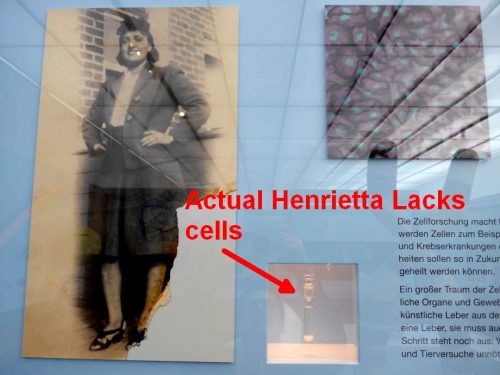
This was interesting. A chart of all the different possible methods of assisted reproduction such as male infertile, female infertile, female-female couple, male-male couple, etc. Green = legal in Germany; red = illegal; yellow = legal status unclear. Grey dots indicate rarity of cases, from rare to common.
Hard to tell in the photo but this is a 3-foot long model of a potato with a nice story. In 2005 there was an uproar from consumers and farmers because a very popular (normal-sized) variety of potato was taken off the market by the company that had bred it. Their license (a patent of sorts) had expired and since they could no longer charge licensing fees, they wanted to force people to buy their other varieties. Farmers took the case to the Federal Seed Depository and won. The authorities required the company to release the variety for unrestricted license-free propagation.
